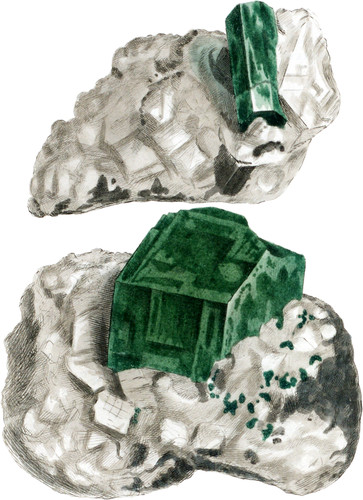 Enlarge
Enlarge
Exotic Mineralogy
Emerald
- Syn.
- Smaragdus, Autorum.
- Emerald. Kirwan, 1, 247. Aikin, 193.
- Schmaragd. Werner, &c.
- Emeraude. Haüy, 2, 516. Tabl. 32. Bournon Catal. 39.
Of all the precious stones the Emerald is acknowledged to be the most pleasing in colour; and although not equal in splendour or hardness to the others, is held in high estimation when clear and large. Good Emeralds are obtained at present from Santa Fe, in Peru, South America. The ancients must have been acquainted with some other part of the world in which they were to be procured, as there still remain several antique gems of this species.The Emeralds described by the older classics were various kinds of green stone, such as Jasper, &c. It is probable that the true Emerald was imported into Europe from the interior of Africa.
The Aigue-marine, or Beryll, possesses all the properties of the Emerald except its colour, and they can only be considered as varieties, the latter being indebted to an admixture of oxide of Chrome for its beautiful hue. The crystals of Beryll have commonly striated sides, and this has been looked upon as a distinguishing character, but it is by no means constant. Other trifling distinctions have been noticed, but they are such as are usually met with among acknowledged varieties oi' other minerals.
The line specimens figured are the pride of the collection at the British Museum. The matrix is Carbonate of Lime, in rounded crystals among argillacious Schistus.
The following is the analysis of Emerald given by Vanquelin:
| Silica | 64.50 |
| Alumina | 16.00 |
| Glucina | 13.00 |
| Oxide of Chrome | 3.25 |
| Lime | 1.60 |
| Water | 2.00 |
| 100.35 |
The spec. grav. varies from 2.600 to 2.775: it is fusible, and rather harder than Quartz.

